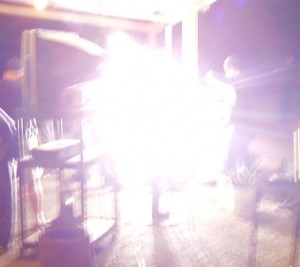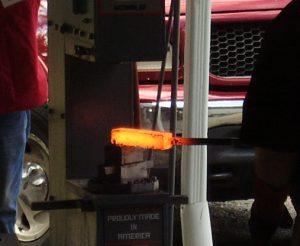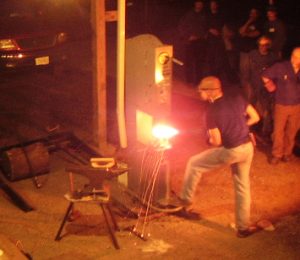 Of all the bladesmithing processes, the one surrounded by the most mystery, the process that has spawned the most legend and myth, is unquestionably forge folding.
Of all the bladesmithing processes, the one surrounded by the most mystery, the process that has spawned the most legend and myth, is unquestionably forge folding.
Forge folding, the process that yields folded steel, is a general term to describe several different processes that different cultures have used since steel was first made. The physics of the process are fairly simple: steel is heated to forging temperature, hot cut about 3/4 through, folded over on itself, fluxed, heated again (but now to welding temperature), and then subjected to pressure by hammer blows or from a press. The heat and pressure act together to weld the two faces of the steel together. This element is called forge welding…
 Murphy Lives Here
Murphy Lives Here
An awful lot of things can and do go awry in forge welding.
Failed welds are the most obvious failure. A failed weld is usually the result of either not reaching welding temperature before attempting the weld, or reaching welding temperature but waiting too long to attempt the weld (there is a window of only a few seconds on a small work piece). Both result in the steel not sticking and the failure is obvious; the two pieces that are supposed to stick together fall apart.
Inclusions are foreign objects that get caught in the weld. A small one can go unnoticed if deep enough, but shallow ones can show as surface imperfections during the grinding process. All of them are serious enough to cause a blade to break or delaminate at an inopportune moment. They are usually composed of forge scale (iron oxide) or flux (most smiths use anhydrous borax) which does not get pushed out of the weld. They can be due to sloppy welding but are sometimes due purely to bad luck.
(Speaking of luck, even though modern smiths tend not to be as superstitious as our ancestors, we still do some things that date back a few centuries just to “make sure.” Something I find interesting is the fairly common practice of splashing some beer into the hot forge to pacify the fire sprites who reside there and, depending on their mood, encourage them either to help or hinder the resident smith. I confess that I do it on occasion. I’m sure this practice has nothing to do with having an excuse for having cold beer in the ever sweltering smithy.)
Cold shuts are essentially an area of failed weld surrounded by successful weld. This forms a pocket of gas that expands and appears as a blister in the work piece. While a failed weld can always be cleaned and re-welded, a piece with a cold shut, in my opinion, needs to be discarded and the work begun anew. Although I have heard that some very skilled smiths can hot slit a cold shut, force out the gas, and complete the weld, I don’t think it’s worth the effort or risk.
 Modern Damascus (And Not a City in Syria)
Modern Damascus (And Not a City in Syria)
I like to keep things simple and use terms that are widely understood and generally accepted. You may hear someone say pattern welded steel. Have no doubt, it’s Damascus steel. To make things very simple, I’m going to explain to you how I make random pattern Damascus steel. There are many pattern and steel combinations available to the modern smith, but random is the most basic pattern and 1084 and 15N20, in my opinion, is the most foolproof combination of steels.
I start with about 8 alternating layers of 1084 and 15N20 that are about 1-1/2 in. × 3 in. and are MIG welded together on the corners and have a piece of steel bar welded on as a handle. The MIG welding keeps everything together until I make the first forge weld, and the steel bar makes it easier to handle than using tongs. I heat this billet up to “yellow heat” in the forge and then pull it out, turn it on its side to expose the gaps between the layers, and sprinkle on some borax.
The billet goes back in the forge, and I watch the borax flux until it first bubbles, then smoothes out and becomes shiny like butter melted in a pan. I then pull the billet out and very quickly put it in my 24-ton hydraulic press and make the first weld. The molten flux flows out of the layers and carries with it any oxide and foreign material that may have been caught in the weld. If successful, I now have 8-layer Damascus that I can forge into a blade without any folding. I like to have 64–512 layers, so I’ll usually cut, fold, and press 3–6 times. This process doesn’t make super steel. In fact, every time steel is heated to these temperatures, there is a risk that the steel can be ruined by changes made by the heat to the metal’s chemical structure.
Damascus steel is made for aesthetic purposes only. The pattern is brought out by etching. I use ferric chloride because it’s relatively safe and very effective. When etched, the 1084 darkens and the 15N20 stays bright because it contains nickel (that’s what the “N” stands for), which resists the etch.
How The Japanese Do It (Or Whoever Smelt It…)
Traditional Japanese sword steel is made from a very low quality and low yield ore called iron sand or black sand. The steel that results from smelting this sand is called tamahagane, which has fairly low carbon content and is full of impurities, such as copper, which have deleterious effects on the steel. The smelt yields blooms of iron, low carbon steel, and high carbon steel; each has its uses and is tested to determine its identity and sorted. Traditional Japanese smiths burn out the impurities by repeatedly folding and forge welding the steel. The folding also evens out the carbon to create more homogenous steel. The migration of carbon through steel takes a painfully long time, but folding helps speed the process because it repeatedly moves the surface of the billet to the middle. Bear in mind that what has been made is a raw material; it still has to be forged into a blade, hardened, tempered, polished, and mounted.
There are no rules about how many times the steel is folded. The smith knows when it’s ready by how it looks, feels, and moves under the hammer.
The end result is an amazing testament to the hard work and dedication of the ancient smiths who created this process through trial and error. They took an inferior ore and turned it into steel that is still considered to be good blade steel even by today’s standards. That steel, tamahagane, was used to make one of the most famous and myth-spawning blades in human history—the legendary katana.

I find bladesmithing fascinating, it is almost a primal thing, building something yourself.
Ofcourse, using it is also fun :-)
@Darkjoy – That primordial aspect is what keeps me interested. It can’t get much more basic than using fire to create. :)
Todd, can I ask a somewhat related question?
Back in pre-industrial smelting days, were ironworkers restricted to making single items out of what ever sized bloom they were able to smelt or could blooms be joined together somehow so that larger items could be made? When ever I’ve seen a bloom worked it seems they hammer it into a rough rectangular shape which may not necessarily be of enough volume to make, for example, a sword. If they could be joined together, was it using a technique something like the welding you’ve just described? Thanks.
@Greg – Greg, you hit the nail on the head. After the bloom is consolidated by forging it into bars, those bars can be forge welded together to form bigger billets. The only limit on how big a billet can be is the size of the forge because the forge needs to be big enough to bring all the pieces to welding heat at the same time.
I’m glad you had the opportunity to see a smelt and the bloom being worked. It’s not something that’s done every day.
This series is extraordinarily enlightening. Thanks, Todd.
Colin, glad you like it. Tell your friends. :)
Also, there’s a short interview with Todd in the latest Kobold Courier. Which reminds me we should interview some of our other columnists….
Oh please, collect these articles into a .pdf so that we can someday have “The Complete Bladesong of Todd The Blacksmith”.
I promise, the dwarves will drink to your name for twelve generations.
@Colin McComb – My son is thrilled you commented – we’re fans of anything Dragonlance. I’m glad you like the series, and you are most welcome.
@Charles Carrier – I’m sure the kobolds heard you, but I suggest voting on the forums in the web content poll.
Can the dwarves drink to my name whilst they forge Tom Allman’s +3 magnetic axe? :)
Speaking as someone who has spent a large portion of his life learning and practicing the use of real swords to do real things(the last 10 years and counting on Asian sabres), I find it to be an immense relief to find articles that dispel the myths and increase the knowledge base available to people with an interest in blades appearing in more and more places.
You have a produced a very readable and enjoyable set of articles on this particular topic, and the overly-romanticized katana, and for that I whole-heartedly salute you.
Good work, sir!
@Anthony Boyd – Thank you. I really appreciate the encouragement and feedback!